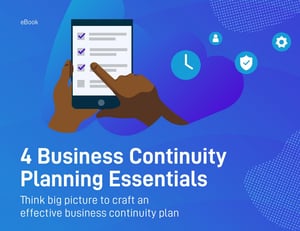As any business can attest, maintaining a business continuity and disaster recovery (BCDR) plan is important to reducing your business risk and downtime. And now you have incident response plans to consider as well. Each business continuity plan (BCP) and disaster recovery plan (DRP) serves a specific purpose and will outline your response strategies, processes, and responsibilities when a disruptive event occurs.
Disasters, big or small, can include things like:
- Natural Disasters: Floods, fires, and blizzards
- Human Error: Accidental deletions or security/data breaches
- Hardware failures or power outages
- Cybersecurity attacks
- And more
No matter what types of events or incidents may attempt to knock your business offline, you will want to have steps you can take to ensure your technology is useable to keep your business, in business. The benefit of maintaining these plans is that you can continue business operations with minimal downtime, as well as the least possible productivity and revenue interruption.

What is a business continuity and disaster recovery plan?
The goal of a BC/DR plan is, as TechTarget explains, to “limit risk and get an organization running as close to normal as possible after an unexpected interruption.”
Business continuity and disaster recovery plans are designed to maintain productivity when problems arise, all the while reducing the risk of data loss and the potential for lost revenue.
However, there are key differences, and these three terms are not interchangeable.
Information in the section below was updated on August 28, 2023.
What are the differences between business continuity, disaster recovery, and incident response plans?
Business Continuity Plan
A business continuity plan is an outline or full document that states how your business will resume operations during a disaster or unplanned incident. The plan includes processes and procedures that your company is dependent on and must implement in order to continue core business functions. You will want the plan to focus on the daily products and services you deliver, as well as quoting and invoicing so that you are able to receive money. These plans are short-term fixes that continue basic business functions, including access to vital company data.
Disaster Recovery Plan
The disaster recovery plan, on the other hand, is the steps your business is going to take to recover after a disaster or event. How are you bringing up the systems you need and recovering business functions? The plan efforts are generally concentrated on bringing your technology back online and prioritizing IT components that will support your business process and functions. While business continuity should cover data accessibility to quickly get important functions running, disaster recovery is the longer-term step to bring your business back to fully functioning.
Incident Response Plan
So what is an incident response plan? This plan is specific to cybersecurity threats and attacks that may impact your business. Like the plans above they are put in place and tested on a regular basis. Your business has IT security tools, monitoring, and likely cybersecurity insurance, however, your team must know what actions to take when a debilitating event occurs. Your incident response plan will include what actions need to be taken to minimize the impact of incidents, quickly restore normal operations, and effectively manage the aftermath.
Be certain to take advantage of outsourced teams that are knowledgeable in conducting a business impact analysis and putting these plans together. The plans and expertise will set your mind at ease. Now, at the same time, review the questions you and your team can ask yourselves to start collecting the information you need to either craft your plans or work with the experts.
What questions do I consider when crafting my company’s business continuity and disaster recovery plan?
As discussed in our eBook, The 4 Business Continuity Planning Essentials, there are several key questions to ask as you work on your company’s specific plan. These questions may not be exhaustive, since no two businesses are the same, but they are a good framework to help you through the process.
1. Ensure Employee Well-Being
If your business is thrown off-kilter by a disaster, such as part of your city flooding (including your office building), then one of your first priorities is to keep employees safe. The second is to keep them informed. They can both be challenging, but make sure your emergency planning sessions address the following questions:
- How will my company keep employees safe during a disaster event?
- How will my company communicate essential information to employees following the event?
- How can my company test its communication methods before a disaster happens, so we know we’re prepared?
2. Keep Customers in the Loop
Once you know your employees are safe, you also need to keep your customers informed about what’s happening with your business.
Are you continuing operations from a different location? Are you shifting to a remote model for the time being?
The important thing here is to make sure that your customers can get their questions, like the ones mentioned in the previous paragraph, answered, so they aren’t surprised by momentary glitches in service.
Consider these questions to keep your customers in the loop:
- What communication methods will we use to reach our customer base?
- How do we plan to handle the influx of customer questions and needs following an event?
- Do we have the necessary strategies in place to keep our company's reputation intact?
3. Enable IT Uptime
When it comes to getting your IT back online following an emergency event, you’ll need to take these questions into consideration:
- What is our current data backup plan?
- How long will it take for our company data to be available following an event?
- Do our employees have access to their necessary applications?
- If our office is unavailable, do we have the ability to shift to a remote model?
- Do we have adequate voice operations for a remote working model?
- When was the last time we tested our data backups and disaster recovery plans?
4. Keep your business moving forward
Midsized businesses can’t afford prolonged periods of downtime. You need to continue business operations as efficiently as possible when responding to a major event, unusual weather patterns, or a disaster. In that case, don’t forget to take these questions into account:
- How long can my business safely afford to be offline?
- Are there technologies we can take advantage of to continue operations?
- Does my business have the right kind of insurance to cover not only damaged technology or office equipment but also warehouse inventories and other assets?
- Are the right people trained on our recovery processes?
- What are the key roles and responsibilities that I need to assign?
Developing a BC/DR plan is no easy feat, but it is a critical aspect of running a business.
There is a lot to think about when drafting your business continuity and disaster recovery plan, and the CoreTech team is here to help. From designing your technological infrastructure and data backups to helping you draft your actual business continuity and disaster plans, our expert consultants are here to answer your questions.
We know that no two businesses are alike, and your IT setup and strategies shouldn’t be either. When you schedule a meeting with us, we take the time to learn about your business goals and needs to recommend the best technological solutions, and plans of action, for you.
In the meantime, I invite you to download our eBook, The 4 Business Continuity Planning Essentials. This guide to forming a BC/DR plan covers these 4 topics in greater detail, providing crucial knowledge and tips for your business's emergency plans.


